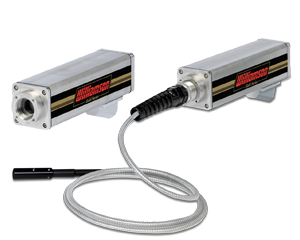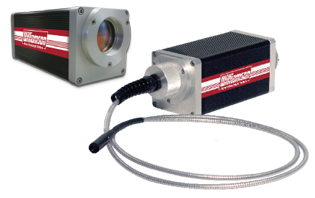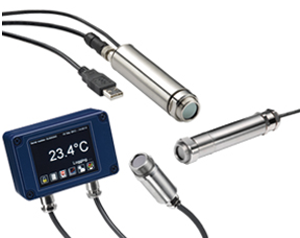Infra-Red Temperature Sensors
In one way or another I have been associated with Williamson since 1973. At that time, I was working for a company that did controls for high density electric heating systems. Williamson had the only non-contact temperature sensors that could accurately measure the target temperature in the presence of all that infra-red energy. Stapleman Corporation has been their representative in Wisconsin since 1981.
Infra-red temperature sensors measure infra-red energy being emitted from the target (part being measured). It is a pretty straight forward measurement, except for three things:
Field of View. A standard sensor reports the average temperature viewed in a spot on the target. If the target does not fill the entire field of view, then the sensor is averaging in the temperature of whatever surrounds the target. This error shows up especially with handheld instruments, but can also come into play when an in-place sensor is bumped or otherwise misaligned.
Interferences. Steam, dust, smoke, humidity, flames all interfere with the reading. The sensor senses the infra-red energy given off from the interferences and averages that into the reading. This is where wavelength really matters because the sensor can be tuned to ignore these interferences. It can be made to look through flames and see (or ignore) clear plastic film. You can read the temperature of the paint being dried or the metal under the paint by using the correct wavelength. See the
 wavelength matters blog.
wavelength matters blog.Emissivity is the inverse of reflectance. We are trying to see the energy being emitted from the target but often get reflections from something else. Emissivity is measured on a scale of 0 to 1 where 1 is a theoretical perfect black body. Measuring hot metals is especially difficult because the emissivity changes with temperature. You have to know the temperature to set the emissivity correctly, but you have to know the emissivity to get the temperature right. Chase your tail.
In the mid 80's the industry came up with ratiometric IR sensors. Measure the temperature at two different wavelengths then calculate the temperature based on the difference between the readings. With this method field of view and emissivity, errors are eliminated and most interferences are ignored. At the time Williamson diverged from the other manufacturers and used a dual wavelength approach instead of the standard two colors. That technology has proven superior in the long run because dual wavelength can be used for much lower temperatures - as low as 200 degF. The superior technology and the concentration on IR sensing means Williamson sensors will work where others have failed.
There are five different product lines ranging from very economical to the most sophisticated sensors on the market. Silver Series comes in short and long wavelength versions with pricing starting at just $210. Yet this series has many advanced features that make the product stand out in a crowded field. This is the lowest priced short wavelength IR sensor on the market.
Silver Series comes in short and long wavelength versions with pricing starting at just $210. Yet this series has many advanced features that make the product stand out in a crowded field. This is the lowest priced short wavelength IR sensor on the market. Gold Series also comes in short and long wavelength versions and adds extra options for more difficult applications. Fiber optic viewing gets into places where a camera style sensor is impractical. And the Gold Series works with available Pro View software.
Gold Series also comes in short and long wavelength versions and adds extra options for more difficult applications. Fiber optic viewing gets into places where a camera style sensor is impractical. And the Gold Series works with available Pro View software. Pro Series comes with a processor built into the sensor and can be tricked out with many extra features that are just not available anywhere else. Check out the
Pro Series comes with a processor built into the sensor and can be tricked out with many extra features that are just not available anywhere else. Check out the  applications pages to see where we have solved difficult problems.
applications pages to see where we have solved difficult problems. Ratio Pyrometers can be used for temperature measurements where nothing else will work. It is the Pro Series with two optical paths to the IR sensor. This sensor reports the hottest temperature it sees regardless of field of view or emissivity or interferences. The dual wavelength version can be used for monitoring temperatures as low as 200 degF.
Ratio Pyrometers can be used for temperature measurements where nothing else will work. It is the Pro Series with two optical paths to the IR sensor. This sensor reports the hottest temperature it sees regardless of field of view or emissivity or interferences. The dual wavelength version can be used for monitoring temperatures as low as 200 degF. Multi-Wavelength pyrometers are unique to Williamson. Because their dual wavelength sensors can handle lower temperatures the aluminum industry came to Williamson to solve their very difficult emissivity problems. The result is the multi-wavelength pyrometers with
Multi-Wavelength pyrometers are unique to Williamson. Because their dual wavelength sensors can handle lower temperatures the aluminum industry came to Williamson to solve their very difficult emissivity problems. The result is the multi-wavelength pyrometers with  ESP that are tuned to specific applications that would be otherwise impossible.
ESP that are tuned to specific applications that would be otherwise impossible.
 MWx Technology is a recent development that adds dynamic ESP algorithms to Multi-Wavelength sensor for better temperature of aluminum rolling mills.
MWx Technology is a recent development that adds dynamic ESP algorithms to Multi-Wavelength sensor for better temperature of aluminum rolling mills.
Williamson has been a strong leader in the industry for many years. You can count on this company to get the job done even if everyone else has failed in the past.
| |
Williamson
70 Domino Drive
Concord, MA 01742
Phone:  800-300-8367 (U.S.A. Only)
800-300-8367 (U.S.A. Only)
Other Phone:  978-369-9607
978-369-9607
Fax: 978-369-5485
Get IR Temperature Sensors Here
What makes Williamson different from their competitors is their slogan – Wavelength Matters. Their focus on wavelength selection allows their instruments to take measurements traditionally considered difficult or impossible to read. This is why they are a top infrared temperature sensors manufacturer. If you have any questions about our Williamson products or the other specialty sensors we offer, do not hesitate to contact us.








